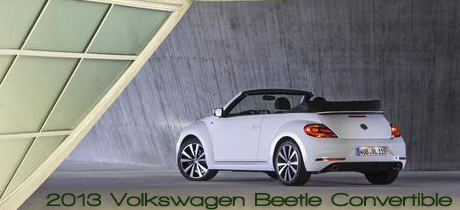
2013 Volkswagen Beetle Convertible Road Test Review
By Bob Plunkett
Not a cloud clots the vivid blue sky above Florida's Gold Coast as we troll the palm-lined Las Olas Boulevard of Fort Lauderdale for a drive test in Volkswagen's 2013 Beetle Convertible, a roly-poly-cute 2+2 bug car with the electrified lid lowered and warm sunlight splashing across a curvaceous car body tinted to a vivid shade labeled Tornado Red.
The new Beetle Convertible, derived from the new third-generation Beetle hatchback, has front-wheel-drive orientation and three powertrain choices including a fired-up Turbo and high-mileage Clean Diesel.
There have been drop-top variations of Volkswagen's original Kaefer (German for Beetle) beginning with the type 15 Convertible from 1949 and extending to the New Beetle Cabriolet (2003-2006) -- all were curvy cute yet downright tepid in the power department.
VW’s 2013 Beetle Convertible, however, looks quite different from predecessors -- and acts different too, due to the juiced-up powertrains.
Riding on a longer, lower and wider platform lifted from the VW Golf, the new Beetle softtop version looks almost muscular now.
It's broad in the face with a tight-lipped mouth tucked below the body-colored front bumper and front fender flares that bulge to accommodate large alloy wheels.
The rescaled body of the 2013 Beetle measures 6.0 inches longer, 3.3 inches wider and 1.1 inches lower than the 2006 New Beetle Cabriolet, which was the last production year for Generation 2.0.
The longer and wider body creates a larger passenger compartment and expanded cargo bay.
Designers retained the 2+2 layout for seats -- a pair of buckets in front of a split/folding bench for two -- but cabin volume increases to 81.4 cubic feet with more legroom and shoulder space for front riders and, despite a lower roofline, more headroom for backseat riders.
A color-keyed dashboard houses the clean-designed instrument panel with three round analog gauges (tachometer, speedometer, fuel gauge) and an integrated multifunction display accessed from a thumb wheel on the steering wheel.
Also, there's a drop-down glovebox (dubbed the "kaeferfach" in German, meaning "beetle bin") that's reminiscent of the dashboard bin in the Generation 1.0 Kaefer.
It only takes 9.5 seconds to lower the power-operated softtop on the new Beetle Convertible, and it even works when the vehicle is moving -- up to 31 mph.
The lid's exterior shell consists of three layers. The outer cover is polyacrylic woven fabric; synthetic rubber forms the middle layer while the inner lining is polyester. Then there's the 3-layer insulation using polyester nonwoven fabric, polyethylene terephthalate insulating fleece and polyester spunboard, plus a headliner composed of foam-laminated fabric.
All 2013 Beetle Convertible editions carry a front independent strut-type suspension with a lower control arm, telescopic dampers and anti-roll bar. The rear suspension is an independent multi-link arrangement with coil springs, telescopic dampers and 18-mm anti-roll bar.
Brakes consist of large discs (ventilated in front, solid at the rear) tied to smart electronic controls. Every issue has an anti-lock brake system (ABS) with electronic brakeforce distribution (EBD) plus VW's anti-slip electronic stabilization control (ESC) program.
Volkswagen offers three powertrain choices for the 2013 Beetle Convertible, with model nomenclature describing engine displacement.
Beetle 2.5L draws from a dual-cam in-line 5-cylinder VW engine with 2.5-liter displacement. It produces 170 hp at 5700 rpm and torque of 177 lb-ft at 4250 rpm.
Shifter is a six-speed electronic automatic and fuel economy figures for this powertrain work out to 21/27 mpg city/highway.
Beetle Turbo editions stock the muscle of a turbo-charged yet gas-sipping 4-cylinder engine. The 2.0-liter in-line 4-cylinder plant -- with turbocharger and intercooler aboard plus direct injection -- produces 200 hp at 5100 rpm and torque of 207 lb-ft at 1700 rpm.
All of the turbo muscle is manipulated through a six-speed manual transmission or VW's twin-clutch and six-speed DSG (Direct Shift Gearbox) Tiptronic automatic.
For the turbo engine the fuel burn numbers tally to 21/30 mpg city/highway with the manual transmission and 21/29 mpg city/highway with the Tiptronic automatic.
Beetle TDI totes a 2.0-liter 4-cylinder engine that burns ultra-low sulfur diesel (ULSD) fuel with electronically controlled turbocharger to enhance engine power and torque. It feels vigorous and acts quickly, drawing on the full force of the engine's production of 140 hp peaking at 4000 rpm plus 236 lb-ft of torque at 1750 rpm.
In general, cars equipped with diesel engines achieve better fuel economy figures than do cars with gasoline engines due to the higher energy content of diesel fuel and the overall efficiency of a diesel engine.
For Beetle TDI, the EPA fuel economy scores climb to 28/41 mpg city/highway using the manual shifter and 28/37 mpg city/highway for the Tiptronic automatic.
Volkswagen trims the Beetle Convertible with the three powertrains and various packages: Beetle 2.5L, 2.5L Technology, 2.5L Sound + Navigation, TDI, TDI Sound + Navigation, Turbo, Turbo Sound, Turbo Sound + Navigation.
The MSRP figures range from $24,995 to $32,395.
For more information on Volkswagen vehicles, click here.
|